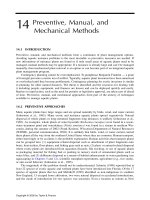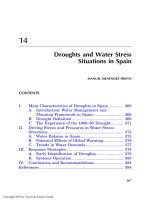Management 12e richard draft chapter 14
Bạn đang xem bản rút gọn của tài liệu. Xem và tải ngay bản đầy đủ của tài liệu tại đây (1020.02 KB, 27 trang )
Chapter 14
Understanding Individual Behavior
© 2016 Cengage Learning. All Rights Reserved. May not be scanned, copied or duplicated, or posted to a publicly accessible website, in whole or in part.
Value and Difficulty of Knowing Yourself
Self-awareness: Being aware of the internal aspects of one’s nature, such as
personality traits, beliefs, emotions, attitudes, and perceptions, and
appreciating how your patterns affect people
2
© 2016 Cengage Learning. All Rights Reserved. May not be scanned, copied or duplicated, or posted to a publicly accessible website, in whole or in part.
Enhance Your Self-Awareness
Soliciting Feedback
Seeking feedback to enhance self-awareness improves performance and
job satisfaction
Self Assessment
Reflection to gain insights into oneself from the results of self-assessment
instruments
3
© 2016 Cengage Learning. All Rights Reserved. May not be scanned, copied or duplicated, or posted to a publicly accessible website, in whole or in part.
14.1 Two Keys to Self-Awareness
4
© 2016 Cengage Learning. All Rights Reserved. May not be scanned, copied or duplicated, or posted to a publicly accessible website, in whole or in part.
Job Satisfaction and Trust
Job Satisfaction – A positive attitude toward one’s job
Organizational Commitment – An employee’s loyalty to and
engagement with the organization
Trust is an important component of organizational commitment
Managers want the benefit of loyal, committed employees
5
© 2016 Cengage Learning. All Rights Reserved. May not be scanned, copied or duplicated, or posted to a publicly accessible website, in whole or in part.
14.2 Rate Your Job Satisfaction
6
© 2016 Cengage Learning. All Rights Reserved. May not be scanned, copied or duplicated, or posted to a publicly accessible website, in whole or in part.
Perception
Perception is the cognitive process people use to make sense of the
environment
Perceptual Distortions – Errors in perceptual judgment
Stereotyping: Generalizing about group or individual
Halo effect: Impression based on one characteristic
7
© 2016 Cengage Learning. All Rights Reserved. May not be scanned, copied or duplicated, or posted to a publicly accessible website, in whole or in part.
14.3 The Perception Process
8
© 2016 Cengage Learning. All Rights Reserved. May not be scanned, copied or duplicated, or posted to a publicly accessible website, in whole or in part.
14.4 Perception—
What Do You See?
9
© 2016 Cengage Learning. All Rights Reserved. May not be scanned, copied or duplicated, or posted to a publicly accessible website, in whole or in part.
14.5 How Accurate Is Your Perception?
10
© 2016 Cengage Learning. All Rights Reserved. May not be scanned, copied or duplicated, or posted to a publicly accessible website, in whole or in part.
Attributions
Attributions – Judgments about the cause of a person’s behavior
Biases when making attributions
Fundamental attribution error – Underestimating the influence of
external factors and overestimating the influence of internal factors
Self-serving bias – giving too much credit for oneself when a job is done
well, and blaming external factors for failure to perform
11
© 2016 Cengage Learning. All Rights Reserved. May not be scanned, copied or duplicated, or posted to a publicly accessible website, in whole or in part.
Personality Traits
Extroversion
Agreeableness
Conscientiousness
Emotional stability
Openness to experience
12
© 2016 Cengage Learning. All Rights Reserved. May not be scanned, copied or duplicated, or posted to a publicly accessible website, in whole or in part.
14.6 The Big Five Personality Traits
13
© 2016 Cengage Learning. All Rights Reserved. May not be scanned, copied or duplicated, or posted to a publicly accessible website, in whole or in part.
Attitudes and Behaviors Influenced by
Personality
Locus of Control – Responsibility of success/failure within oneself vs.
outside forces
Authoritarianism – Power and status differences should exist within
organization
Machiavellianism – Focus on acquiring power
Different problem-solving styles and approaches:
Myers-Briggs Type Indicator assessment
14
© 2016 Cengage Learning. All Rights Reserved. May not be scanned, copied or duplicated, or posted to a publicly accessible website, in whole or in part.
14.7 Measuring Locus of Control
15
© 2016 Cengage Learning. All Rights Reserved. May not be scanned, copied or duplicated, or posted to a publicly accessible website, in whole or in part.
14.8 What’s Your Mach?
16
© 2016 Cengage Learning. All Rights Reserved. May not be scanned, copied or duplicated, or posted to a publicly accessible website, in whole or in part.
14.9 Four Problem-Solving Styles
17
© 2016 Cengage Learning. All Rights Reserved. May not be scanned, copied or duplicated, or posted to a publicly accessible website, in whole or in part.
Emotions
A mental state that arises spontaneously within a person based on
interactions
People cannot be separated from their emotions
Managers can influence positive or negative emotions at work
Emotional contagion
Good managers pay attention to people’s emotions
18
© 2016 Cengage Learning. All Rights Reserved. May not be scanned, copied or duplicated, or posted to a publicly accessible website, in whole or in part.
14.10 Positive and Negative Emotions
19
© 2016 Cengage Learning. All Rights Reserved. May not be scanned, copied or duplicated, or posted to a publicly accessible website, in whole or in part.
Emotional Intelligence
Self-awareness
Self-management
Social awareness
Relationship management
20
© 2016 Cengage Learning. All Rights Reserved. May not be scanned, copied or duplicated, or posted to a publicly accessible website, in whole or in part.
Basic Principles for Self-Management
Clarity of mind
Clarity of objectives
An organized system
21
© 2016 Cengage Learning. All Rights Reserved. May not be scanned, copied or duplicated, or posted to a publicly accessible website, in whole or in part.
14.11 Follow the Steps to Get Organized
22
© 2016 Cengage Learning. All Rights Reserved. May not be scanned, copied or duplicated, or posted to a publicly accessible website, in whole or in part.
Stress and Stress Management
Challenge stress
Stress that challenges and helps increase focus
Threat stress
Stress that is counterproductive
Presenteeism – people go to work, but are too stressed to be productive
23
© 2016 Cengage Learning. All Rights Reserved. May not be scanned, copied or duplicated, or posted to a publicly accessible website, in whole or in part.
14.12 The Yerkes-Dodson Stress Curve
24
© 2016 Cengage Learning. All Rights Reserved. May not be scanned, copied or duplicated, or posted to a publicly accessible website, in whole or in part.
Stress and Stress Management
Type B Behavior
Pattern that lacks Type A
characteristics and includes more
balanced, relaxed lifestyle
Type A Behavior
Pattern characterized by extreme
competitiveness, impatience,
aggressiveness, and devotion to
work
25
© 2016 Cengage Learning. All Rights Reserved. May not be scanned, copied or duplicated, or posted to a publicly accessible website, in whole or in part.









